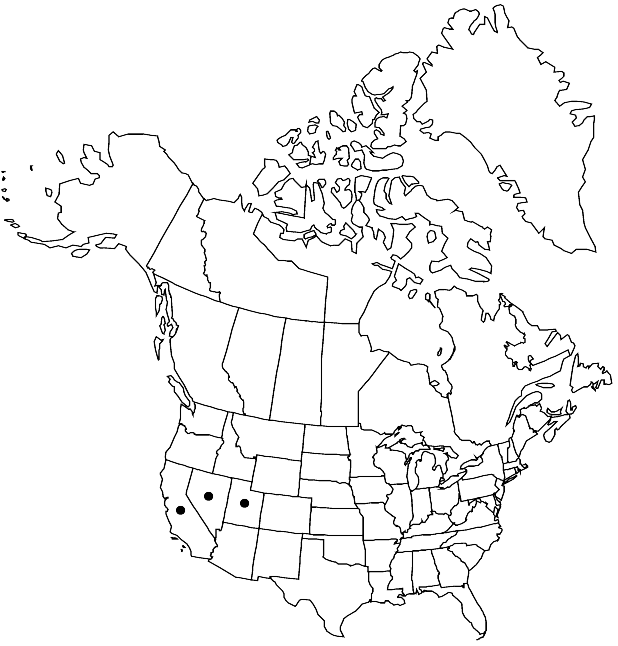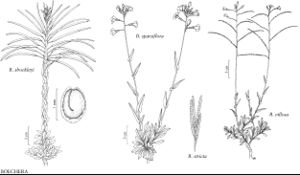Boechera shockleyi
Brittonia 55: 3. 2003.
Perennials; usually short-lived; sexual; caudex not woody, (rarely with persistent, crowded leaf-bases). Stems usually 1 per caudex branch, arising from center of rosette near ground surface, (0.8–) 2–5 dm, densely pubescent proximally, trichomes short-stalked, 7–12-rayed, 0.1–0.2 mm, densely to sparsely pubescent distally. Basal leaves: blade oblanceolate, 3–10 mm wide, margins entire, not ciliate, surfaces densely pubescent, trichomes short-stalked, 7–12-rayed, 0.1–0.2 mm. Cauline leaves: 14–60, concealing stem for most of length; blade auricles 0.5–4 mm, surfaces of distalmost leaves densely pubescent. Racemes 20–70-flowered, usually unbranched. Fruiting pedicels divaricate-ascending, straight, 7–28 mm, pubescent, trichomes appressed, branched. Flowers ascending at anthesis; sepals pubescent; petals lavender, 6–9 × 0.8–1.2 mm, glabrous; pollen ellipsoid. Fruits divaricate-ascending, not appressed to rachis, not secund, usually curved, rarely straight, edges parallel, 4.5–11 cm × 1.5–2 mm; valves glabrous or sparsely pubescent throughout; ovules 140–190 per ovary; style 0.05–0.6 mm. Seeds sub-biseriate, 1–1.3 × 0.7–0.8 mm; wing distal or, rarely, absent, 0.05–0.1 mm wide.
Phenology: Flowering Apr–May.
Habitat: Rock outcrops (primarily dolomite) and gravelly soil in desert scrub, sagebrush, and pinyon-juniper woodlands
Elevation: 1200-2200 m
Distribution

Calif., Nev., Utah.
Discussion
Boechera shockleyi is a distinctive sexual species recognizable by the combination of strongly overlapping cauline leaves, a dense covering of minute, 7–12-rayed trichomes, and relatively long, curved, divaricate-ascending fruits with sub-biseriate seeds. It is most similar to B. inyoensis, but differs from that species in its narrower (0.8–1.2 versus 1.2–2 mm) petals, eciliate basal leaves with smaller (0.1–0.2 versus 0.2–0.7 mm) trichomes, greater number (140–190 versus 74–134) of ovules per ovary, and shorter (1–1.3 versus 1.7–2 mm) seeds with distal (versus continuous) wings.
Selected References
None.
Lower Taxa
"elongated" is not a number."thick" is not a number."dm" is not declared as a valid unit of measurement for this property."dm" is not declared as a valid unit of measurement for this property.
